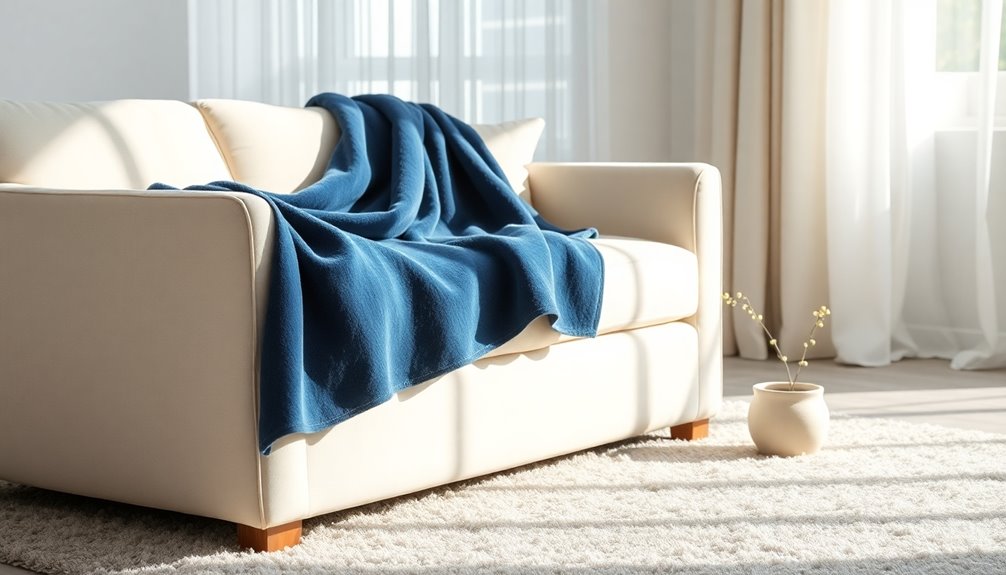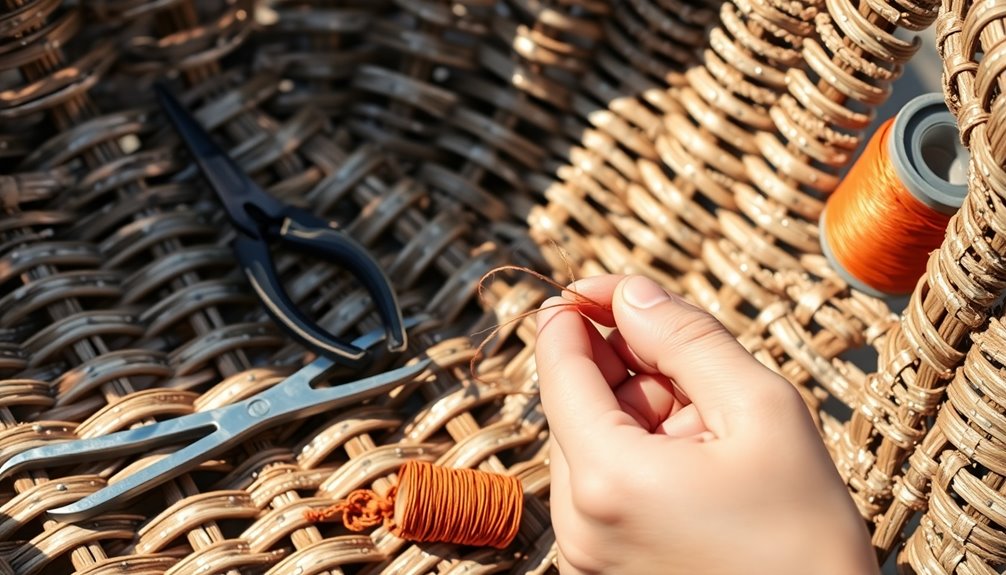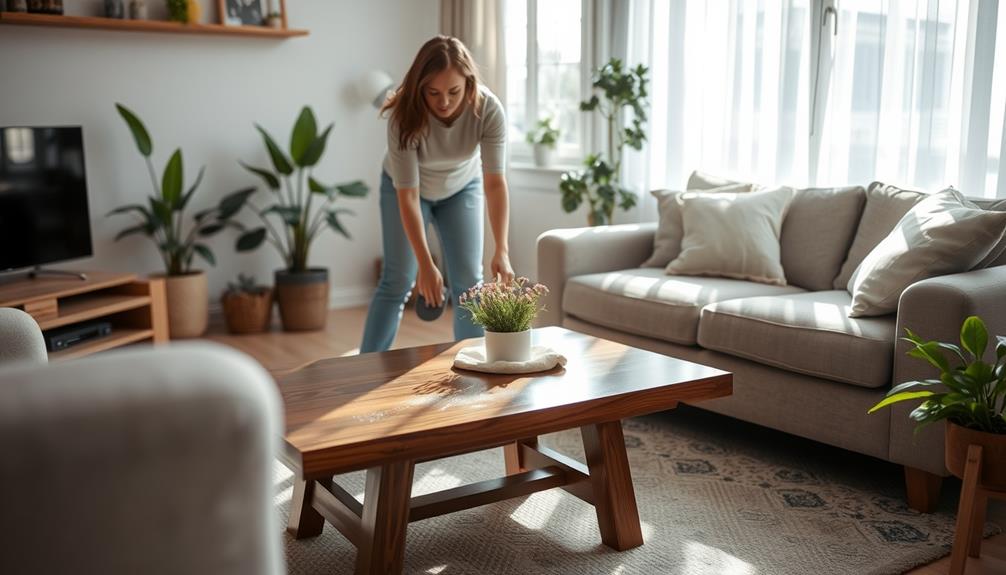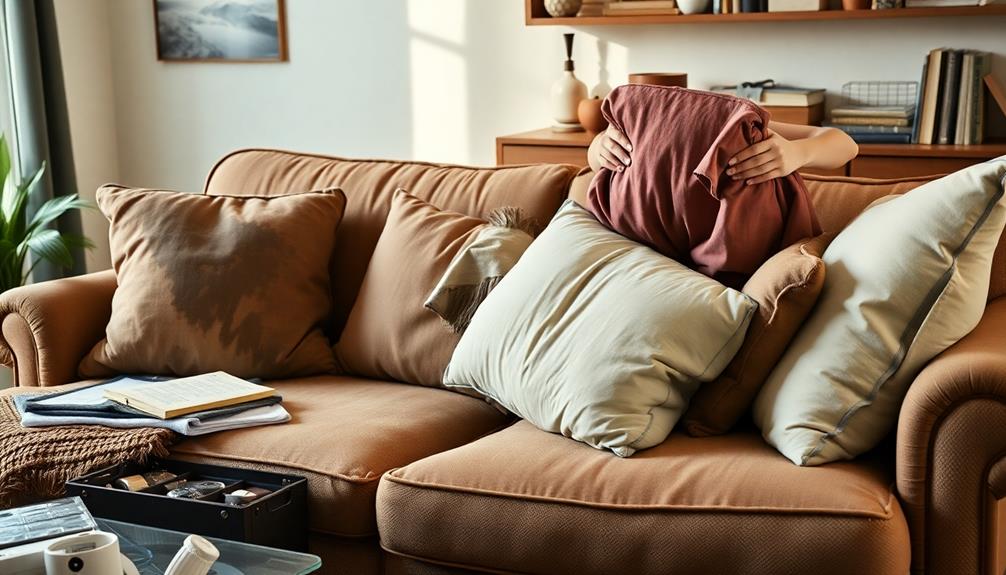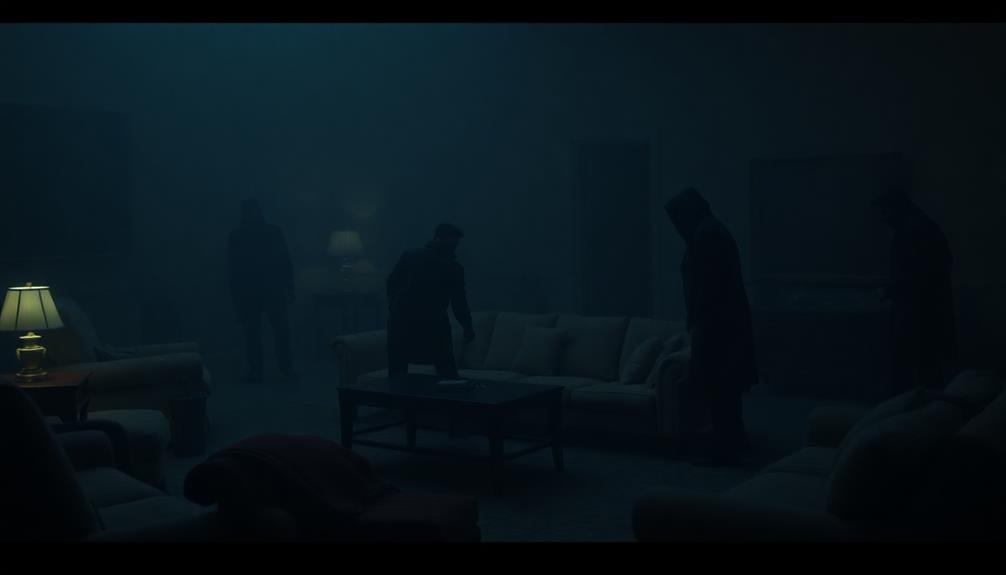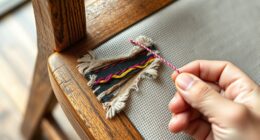To drape a throw on your sofa, start by folding it in half lengthwise for a clean look. Drape it over the backrest, so it hangs down evenly on both sides. For a cozy vibe, let one end cascade slightly over an armrest, creating an inviting touch. You can also layer different textures to enhance visual appeal. Remember to adjust the throw regularly to maintain its shape and prevent matting. Choosing the right materials adds warmth and durability, ensuring your space feels stylish and comfortable. Discover more tips to elevate your sofa’s aesthetic further. Additionally, consider adding decorative pillows that complement your throw to create a cohesive look. If you’re looking to refresh your space even further, explore how to disassemble a sofa bed, which can free up room for other decorative elements or allow for a thorough cleaning underneath. By combining these techniques, you can ensure your living area looks polished and inviting.
Key Takeaways
- Choose a lightweight throw for easy draping that won't stretch the fabric of the sofa.
- Drape the throw over the backrest for a casual, inviting look.
- Use a waterfall draping style to create elegant folds that enhance visual appeal.
- Layer throws by placing a heavier one on the back and a lighter one on the armrests for comfort.
- Regularly reposition and fluff the throw to maintain its aesthetic and prevent matting.
Introduction
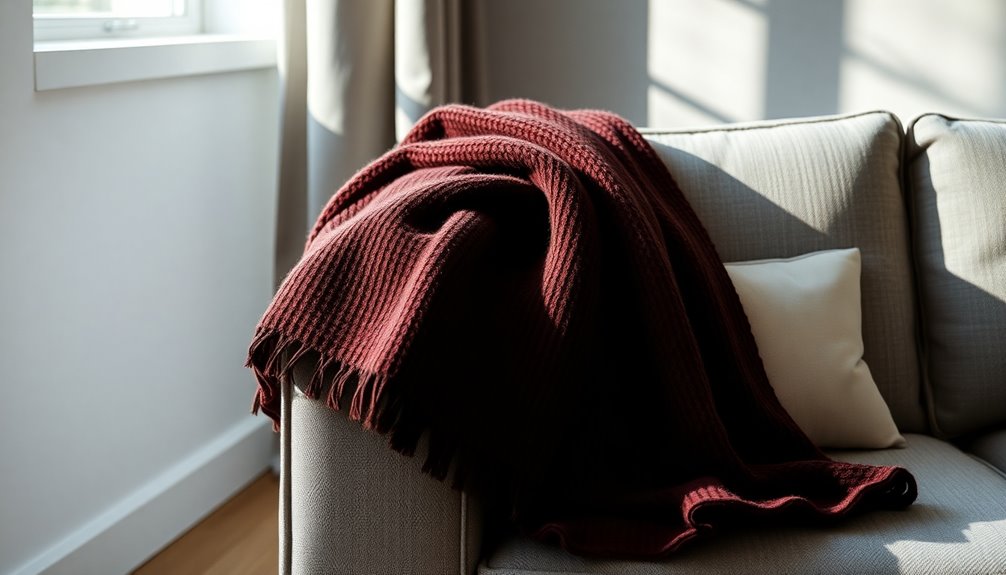
When you choose a throw for your sofa, it's important to think about how to care for it. Regular fabric care can keep your throw looking fresh, and knowing specific cleaning techniques can save you from mishaps, like red wine spills. Let's explore some practical tips to ensure your throw stays beautiful and functional.
Routine Fabric Care Tips
Caring for your throw blanket is essential to keep it looking fresh and cozy for years to come. Always check the care label for specific washing instructions, as different fabrics may require different handling. Most throws benefit from a wash with gentle detergent in cold water, since hot water can shrink or damage delicate materials.
If your throw is machine-washable, skip the fabric softeners, which can leave a residue that diminishes the blanket's softness and absorbency. Instead, focus on routine care that preserves its quality. Regularly shaking out and fluffing your throw prevents matting and bunching, helping to maintain its appearance over time.
When drying, air drying is often the best option. High heat from dryers can lead to shrinkage and deterioration of fibers, so lay it flat or hang it up to dry naturally. Following these simple tips will ensure your throw blanket continues to feel inviting and looks beautiful on your sofa. By incorporating these practices into your routine, you'll enjoy the cozy comfort of your throw for many seasons to come. Additionally, maintaining a clean indoor environment with air purifiers can further enhance the overall comfort of your living space.
Fabric-Specific Cleaning Techniques
Understanding the right cleaning techniques for different fabrics is crucial to maintaining the beauty and longevity of your throw blankets. For cotton throws, machine wash them in cold water and tumble dry on low to prevent shrinkage. Always follow the care instructions on the label for the best results. When it comes to wool throws, you should hand wash them in lukewarm water or consider dry cleaning to maintain their shape and prevent felting.
If you have fleece throws, machine wash them on a gentle cycle, but skip the fabric softeners; they can ruin the texture and warmth of the fleece. For throws with embellishments or delicate materials like silk, opt for spot cleaning with a mild detergent to avoid any damage.
Before you start cleaning your throws, always check the specific care instructions on the label, as different brands and materials may have unique requirements. By taking the time to understand and apply these fabric-specific cleaning techniques, you'll ensure your throws remain fresh and beautiful for years to come.
Treating Red Wine Spills
Red wine spills can quickly turn a cozy evening into a stressful situation, but acting fast can save your throw blankets. When you notice a spill on your couch, grab a clean cloth or paper towel immediately. Blot the area gently to absorb the excess liquid—don't rub, as that will only work the wine in deeper.
Next, sprinkle salt or baking soda on the spill. These natural absorbents help lift the wine, so let it sit for several minutes before vacuuming it up. For lingering stains, mix one part hydrogen peroxide with one part dish soap. Apply this solution to the stain and let it sit for 30 minutes before blotting it again with a clean cloth.
If the stain remains stubborn, consider a commercial stain remover designed specifically for wine. Make sure to follow the manufacturer's instructions carefully. Always test any cleaning solution on an inconspicuous area of your throw or couch first to avoid discoloration or damage. By taking these steps, you can maintain the style and coziness of your living space, ensuring your blankets look great and are ready for your next evening in.
Sofa Shielding Techniques
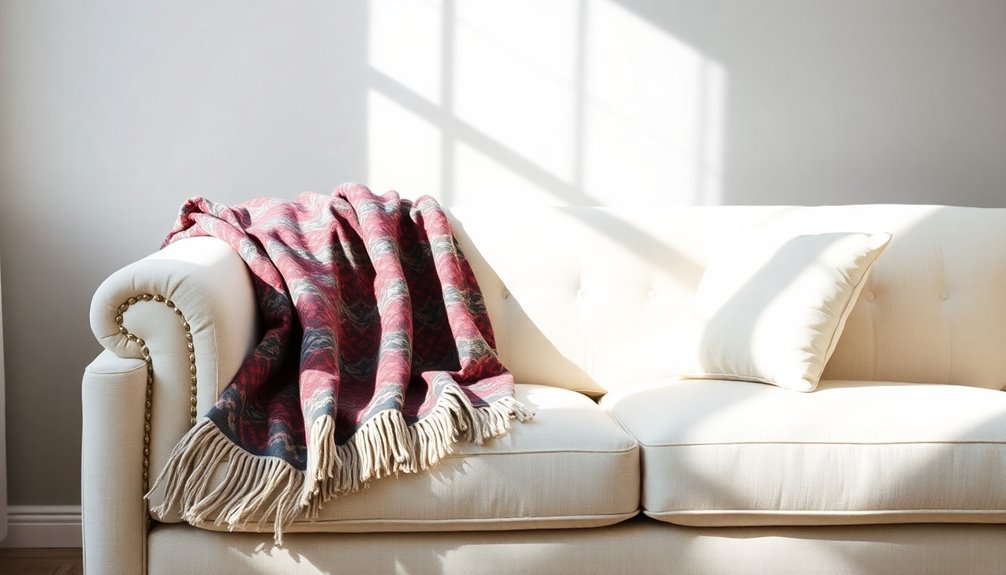
When it comes to shielding your sofa, choosing scratch-resistant fabrics is key to maintaining its look. Layering for added warmth not only enhances comfort but also boosts protection against wear. Plus, minimizing fabric friction can help keep your throw in place and your sofa looking sharp. Additionally, consider scheduling regular maintenance to ensure your sofa remains in top condition and prolong its lifespan.
Scratch-Resistant Fabric Choices
Choosing scratch-resistant fabrics for your sofa can significantly enhance its longevity and maintain its appearance. When you're looking for the perfect material, consider options like microfiber, leather, or polyester. Microfiber is particularly effective at resisting scratches and stains, making it an ideal choice if you have pets or kids. You can stylishly drape throws over your couch, adding coziness while ensuring the fabric remains protected.
Leather offers a sleek look, and it's relatively resistant to scratches, but keep in mind it requires regular maintenance to stay in top shape. Polyester blends are another great option; they're scratch-resistant, easy to clean, and can mimic the look and feel of natural fibers, giving you versatility in your décor.
Always check the fabric ratings, like the Martindale rub test, to ensure your chosen material can withstand everyday wear and tear. By selecting one of these durable fabrics, you're not just enhancing your couch's aesthetic appeal, but also ensuring it stays looking fresh and stylish for years to come. Additionally, opting for materials that are eco-friendly and safe contributes to a healthier living environment. So, as you drape those throws, you can enjoy both beauty and practicality in your living space.
Layering for Added Warmth
To create a cozy and inviting atmosphere, layering throws on your sofa is a fantastic technique, especially during colder months. By draping heavier throws, like wool or chunky knits, you'll enhance warmth and comfort, effectively trapping heat and shielding against drafts.
Start by selecting throws of varying textures and weights. Combining these will create a visually appealing look while maximizing warmth. Drape a thick, knitted throw over the backrest for snugness, and add lighter throws across the armrests for an inviting touch. This layering effect not only adds to the aesthetic but also provides additional insulation against temperature variations. Incorporating natural fibers in your throws, such as cotton and linen, can further enhance comfort and texture.
Don't forget to rotate and wash your throws regularly. Keeping them fresh ensures they continue to offer both warmth and a cozy vibe throughout the seasons. You'll find that the right combination of throws transforms your sofa into a perfect retreat, ready to embrace you on chilly days. So go ahead, play with different colors and textures to achieve that inviting look while enjoying the added warmth layering brings.
Minimizing Fabric Friction
Minimizing fabric friction is key to keeping your sofa looking great while enjoying the comfort of your throws. Start by choosing lightweight throws made from materials like cotton or fleece. These fabrics glide smoothly over your upholstery, helping to minimize fabric friction. Additionally, consider using protective covers or sofa shields beneath the throw. This barrier reduces wear and tear, extending the life of both your sofa and throw.
When selecting throws, opt for those with a soft texture and low pile. These features decrease friction, preventing snagging and damage to both the throw and your sofa's fabric. Regular rotation of your throws is a smart styling method, as it avoids uneven wear patterns. By repositioning your throws regularly, you ensure that all areas of the sofa maintain their aesthetic appeal and structural integrity.
Finally, be mindful of how you layer your throws. Excessive weight from multiple layers can increase friction and lead to fabric stretching over time. Stick to one or two lightweight throws to keep things cozy without compromising your sofa's look. Embracing these techniques will help you enjoy your throws while protecting your furniture. Additionally, consider integrating smart home devices that can monitor the environment to help maintain optimal humidity levels, which can also protect your upholstery.
Upholstery Stitching Techniques
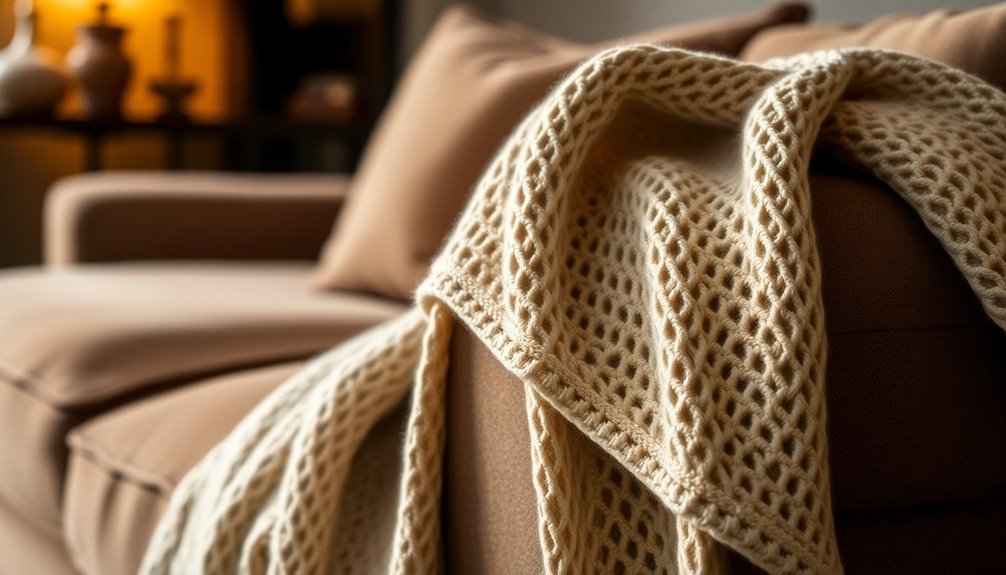
When it comes to upholstery stitching techniques, seam integrity is crucial for ensuring your sofa withstands daily use. You'll want to consider leather repair techniques if your upholstery sustains damage, as well as how cozy texture enhancements can elevate the overall look. Understanding these aspects will help you maintain both the functionality and aesthetics of your furniture.
Seam Integrity Concerns
Ensuring the seam integrity of your upholstery is crucial, especially when draping a throw over a sofa. You want to maintain a polished appearance, and using effective upholstery stitching techniques can help achieve that. For instance, double-stitched seams enhance durability and prevent fabric fraying, which is vital for keeping your throw looking sharp.
Topstitching not only adds a decorative element but also reinforces seam integrity, ensuring the throw stays in place without harming the underlying upholstery. When working with heavier throws, consider employing a zigzag stitch along the edges. This accommodates fabric stretch, helping to prevent distortion of both the throw and the sofa's fabric.
Opt for fabrics with a high thread count, as they're less prone to wear and tear, making them ideal for frequently styled throws. Regular inspection of stitching and seams on both the throw and the sofa is essential. Identifying potential weaknesses early allows for timely repairs, preserving the overall aesthetic and function of your furniture. By paying attention to these seam integrity concerns, you can enjoy a beautifully draped throw that enhances your living space.
Leather Repair Techniques
Leather repair techniques are essential for maintaining the integrity and appearance of your furniture. To ensure durability in your repairs, use a heavy-duty needle and thread specifically designed for leather. Two common stitching techniques you can employ are the whip stitch and the saddle stitch. The whip stitch creates a tight seam by passing the needle through both layers of leather, while the saddle stitch uses two needles for a more secure result.
Before you start stitching, prepare the leather surface by cleaning and conditioning it. This step prevents damage and promotes better adhesion during the repair. As you stitch, it's crucial to maintain consistent tension. Uneven tension can lead to puckering, which not only looks unsightly but can also cause further damage over time.
Additionally, always match the thread color and type to the leather you're repairing. This ensures that your stitching blends seamlessly with the upholstery, making your repair less noticeable. By following these techniques, you can effectively restore your leather furniture, enhancing both its functionality and aesthetic appeal.
Cozy Texture Enhancements
Enhancing the cozy texture of your throw with effective upholstery stitching techniques can transform its appearance and functionality. Throw blankets add warmth and comfort to your sofa, but incorporating stylish stitching can elevate their visual appeal. Techniques like topstitching and piping not only enhance the durability of your throws but also help them maintain their shape and texture while draped over the sofa.
Using contrasting thread colors can create a decorative effect, drawing attention to your throw and adding dimension to the overall look. Quilted stitching is another great option, as it provides added texture that makes your throw more inviting. Reinforced seams in upholstery stitching prevent fraying and wear, ensuring your cozy accents last even with frequent use.
Don't overlook the stitching pattern you choose, either. Whether you opt for straight or zigzag stitches, each can influence how your throw drapes, offering different styling options that enhance your sofa's aesthetic. By applying these cozy texture enhancements, you'll create a visually appealing and inviting space that's perfect for relaxation.
Personalized Throw Blanket Styles
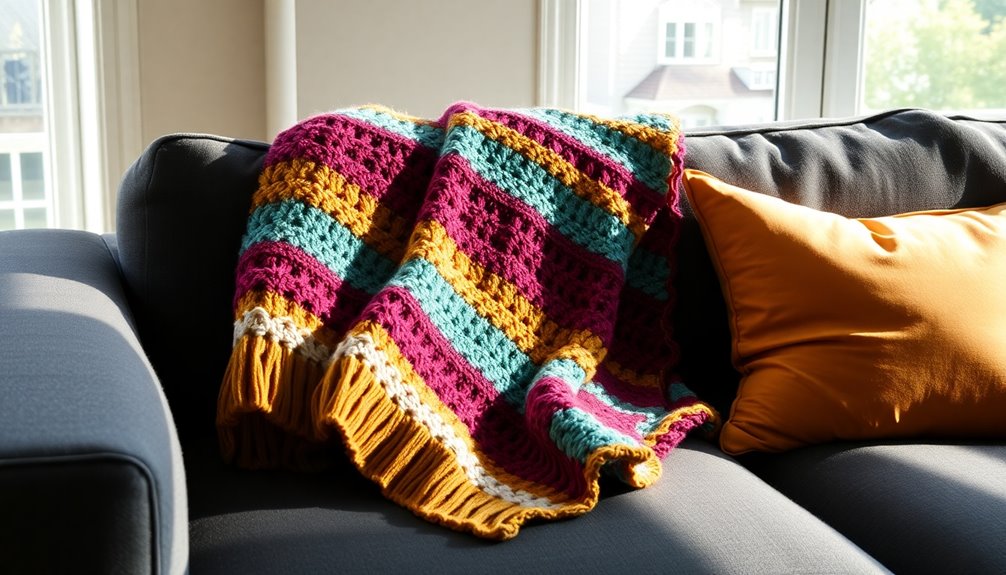
Personalized throw blanket styles often reflect your unique tastes and add a special touch to your living space. By choosing throws that showcase colors, patterns, and textures you love, you can enhance the overall aesthetic of your room. Consider fabrics like chunky knit or faux fur, which not only provide a cozy feel but also introduce a touch of luxury to your sofa.
Custom monogramming or embroidery can elevate a throw blanket, creating a distinctive piece that holds sentimental value—perfect for gifts or family heirlooms. Seasonal themes can also inspire your choices; vibrant plaid patterns are great for fall, while lighter fabrics and brighter colors shine in spring and summer.
To further enhance your sofa's look, layer throw blankets with different textures. This approach not only adds visual interest but also creates a warm and inviting atmosphere. By thoughtfully selecting personalized throw blankets that resonate with your style, you can transform your living space into a cozy retreat that feels uniquely yours. Additionally, incorporating personalized throws can contribute to a sense of emotional well-being within your home environment.
Maintenance for Heirloom Throws
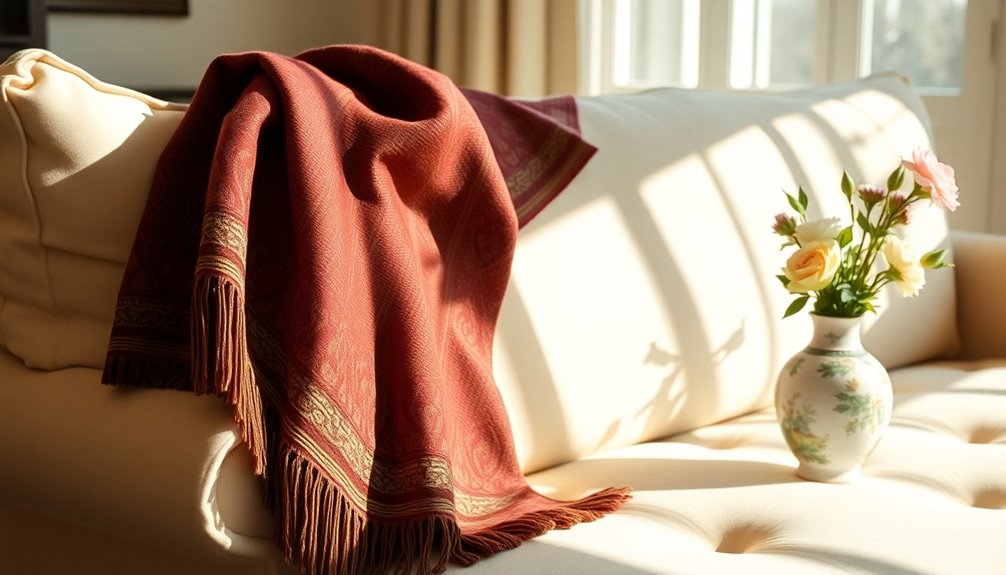
Caring for heirloom throws is vital to preserving their beauty and longevity. Always follow the care instructions on the label to avoid damaging delicate fabrics. Regularly inspect your heirloom throws for any signs of wear and tear. If you notice loose threads or minor damages, address them promptly to maintain their quality.
When it comes to cleaning, consider professional dry cleaning for the best results, or hand wash in cold water with a mild detergent if you prefer a DIY approach. This helps ensure their longevity and keeps them looking pristine.
For storage, choose a cool, dry place. Ideally, use breathable cotton bags or acid-free tissue paper to protect your heirloom throws against moisture and pests. Avoid hanging them for long periods, as this can stretch the fabric. Instead, lay them flat or loosely roll them to prevent any distortion.
Conclusion
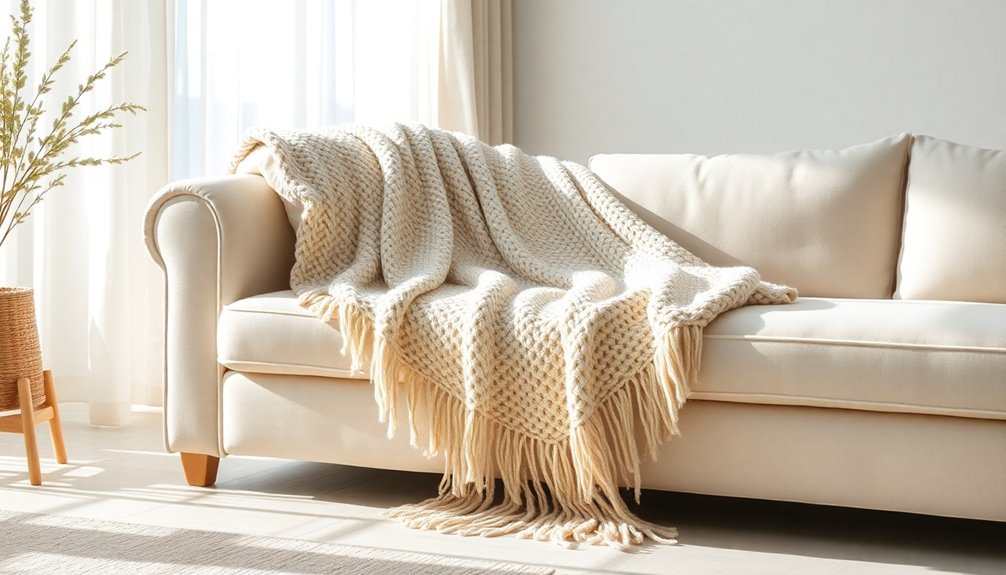
Draping a throw on your sofa not only elevates its visual appeal but also adds comfort to your living space. By choosing the right draping technique, like the waterfall or cozy corner style, you can create a look that reflects your personal style. Remember, the way you fold your throw—whether in thirds or quarters—matters. This maintains a neat appearance while showcasing decorative edges for added flair.
Think about the placement of your throw pillows as well. They can enhance the drape's appearance and contribute to a layered look that radiates coziness. Regularly rotating your throws or experimenting with different draping styles can keep your sofa looking fresh and align with seasonal decor trends. Additionally, consider incorporating soft textiles into your decor to complement the warmth and texture of your draped throws.
Frequently Asked Questions
How Do You Drape a Throw on a Sofa?
When it comes to draping a throw, you've got several stylish options. If you want a structured look, fold the throw into thirds and let it cascade nicely. For a more casual vibe, toss it over one arm with the tassels dangling. You can also use the "Tidy Corner" technique for a polished finish. Don't forget to add decorative pillows to enhance the overall aesthetic and create a cozy atmosphere.
How Can I Make My Sofa Look Better With a Throw?
To make your sofa look better with a throw, start by choosing a color or pattern that complements your existing decor. You can layer it with decorative pillows to add texture and create a cohesive look. Consider using a decorative basket to store extra throws, keeping one corner visible for easy access. Rotating your throws seasonally can also keep the space feeling fresh and inviting, enhancing the overall aesthetic of your living area.
How to Keep a Throw in Place on a Sofa?
To keep a throw in place on your sofa, tuck it behind the cushions to secure it. Choose a weighted throw, like wool or chunky knit, as they tend to drape better. Picking a larger throw can also help it stay put, allowing you to drape it over the arms without it slipping off. If needed, use decorative clips for added security, and remember to adjust and fluff it regularly for a polished look.
How Do You Cover a Couch With a Throw?
To cover a couch with a throw, start by folding the blanket lengthwise into thirds for a tidy appearance. Then, drape it over the back or arm of the couch, letting it cascade down for a cozy vibe. Adjust the placement to showcase any decorative edges or fringes. If you want a structured look, lay it neatly across the seat, ensuring it doesn't hang below the couch for a polished finish.
